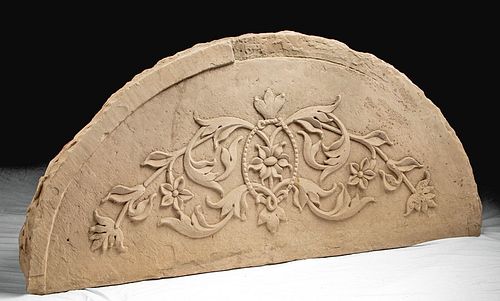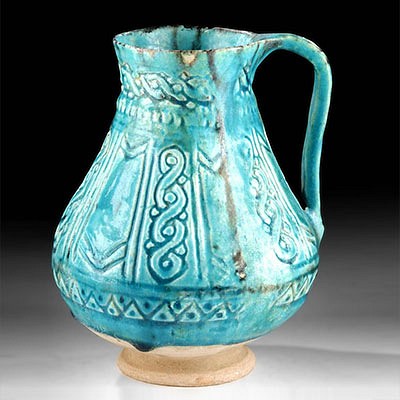17th C. Indian Mughal Sandstone Lintel - Florals
Lot 58
About Seller
Artemis Fine Arts
686 S Taylor Ave, Ste 106
Louisville, CO 80027
United States
Selling antiquities, ancient and ethnographic art online since 1993, Artemis Gallery specializes in Classical Antiquities (Egyptian, Greek, Roman, Near Eastern), Asian, Pre-Columbian, African / Tribal / Oceanographic art. Our extensive inventory includes pottery, stone, metal, wood, glass and textil...Read more
Categories
Estimate:
$3,000 - $4,000
Absentee vs Live bid
Two ways to bid:
- Leave a max absentee bid and the platform will bid on your behalf up to your maximum bid during the live auction.
- Bid live during the auction and your bids will be submitted real-time to the auctioneer.
Bid Increments
| Price | Bid Increment |
|---|---|
| $0 | $25 |
| $300 | $50 |
| $1,000 | $100 |
| $2,000 | $250 |
| $5,000 | $500 |
| $10,000 | $1,000 |
| $20,000 | $2,500 |
| $50,000 | $5,000 |
| $100,000 | $10,000 |
| $200,000 | $20,000 |
About Auction
By Artemis Fine Arts
Oct 29, 2020
Set Reminder
2020-10-29 12:00:00
2020-10-29 12:00:00
America/New_York
Bidsquare
Bidsquare : Art of Asia | Antiquity to Modern Day
https://www.bidsquare.com/auctions/artemis-gallery/art-of-asia-antiquity-to-modern-day-5906
Join us for a special auction featuring artifacts and fine art from the continent of Asia - from Warring States to Western Asia, this auction will have something for everyone. This is one you won't want to miss. Professional in-house shipping for your convenience! Artemis Fine Arts info@artemisgallery.com
Join us for a special auction featuring artifacts and fine art from the continent of Asia - from Warring States to Western Asia, this auction will have something for everyone. This is one you won't want to miss. Professional in-house shipping for your convenience! Artemis Fine Arts info@artemisgallery.com
- Lot Description
Central Asia, India, Mughal Empire ca. 17th century CE. An elegantly carved sandstone semicircle lintel from a temple. The surface is decorated with a graceful, symmetrical representation of flowers and vines. At the center is a six-petaled flower, the tips of the petals pronounced as if hanging down in teardrop form. A carved chain bearing three-pronged leaves at top and bottom encircles this flower, adding a touch of human creation to the natural beauty. A thick, raised border demarcates the curved edge. Size: 2.3" L x 55" W x 25.5" H (5.8 cm x 139.7 cm x 64.8 cm)
Mughal period architecture was a blend of Islamic, Persian, Turkish, and native Indian styles from earlier periods. Towering, slender minarets, bulbous, onion-like domes, large curved gateways, and ornate, symmetrical decorative programs characterize the imaginative and monumental buildings of the period, of which the Taj Mahal is of course the most famous. This reached its peak during the reign of Emperor Shah Jahan, who in addition to the Taj Mahal created the Diwan-I-Am (Hall of Public Audience) and the Moti Masjid (Pearl Mosque). Sadly these extravagant achievements heavily taxed the Mughal people, and by Jahan's death, he had bankrupted his empire. The combination of wealth and artistic patronage of the Mughal period remains unparalleled in Indian history.
Provenance: private J.H. collection, Beaverton, Oregon, USA
All items legal to buy/sell under U.S. Statute covering cultural patrimony Code 2600, CHAPTER 14, and are guaranteed to be as described or your money back.
A Certificate of Authenticity will accompany all winning bids.
We ship worldwide and handle all shipping in-house for your convenience.
#149615The sandstone has flaked in some areas as shown, notably along the upper border as shown. Old collection numbers are written in chalk on the undecorated back. The artwork is well preserved. Deposits on surface commensurate with age.Condition
- Shipping Info
-
All shipping is handled in-house for your convenience. Your invoice from Artemis Gallery will include shipping calculation instructions. If in doubt, please inquire BEFORE bidding for estimated shipping costs for individual items.
-
- Buyer's Premium



 EUR
EUR CAD
CAD AUD
AUD GBP
GBP MXN
MXN HKD
HKD CNY
CNY MYR
MYR SEK
SEK SGD
SGD CHF
CHF THB
THB














